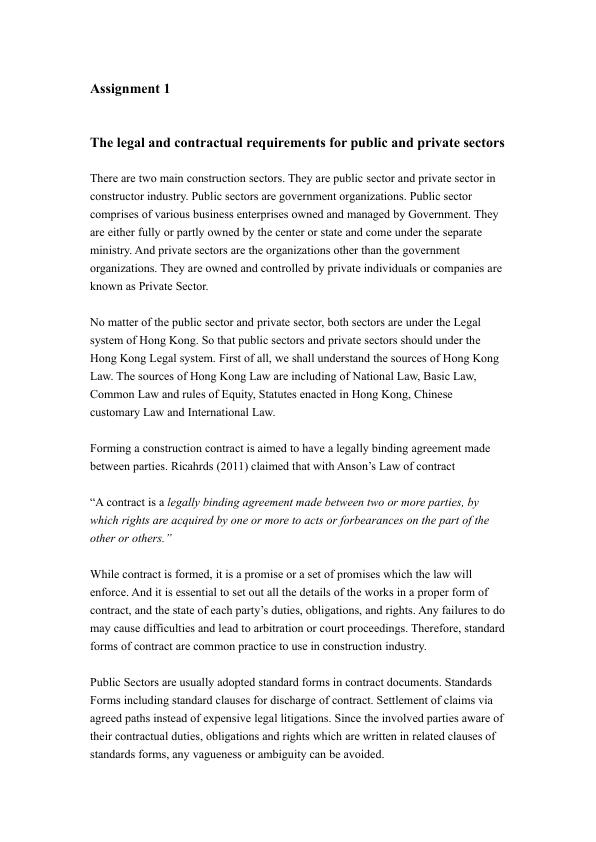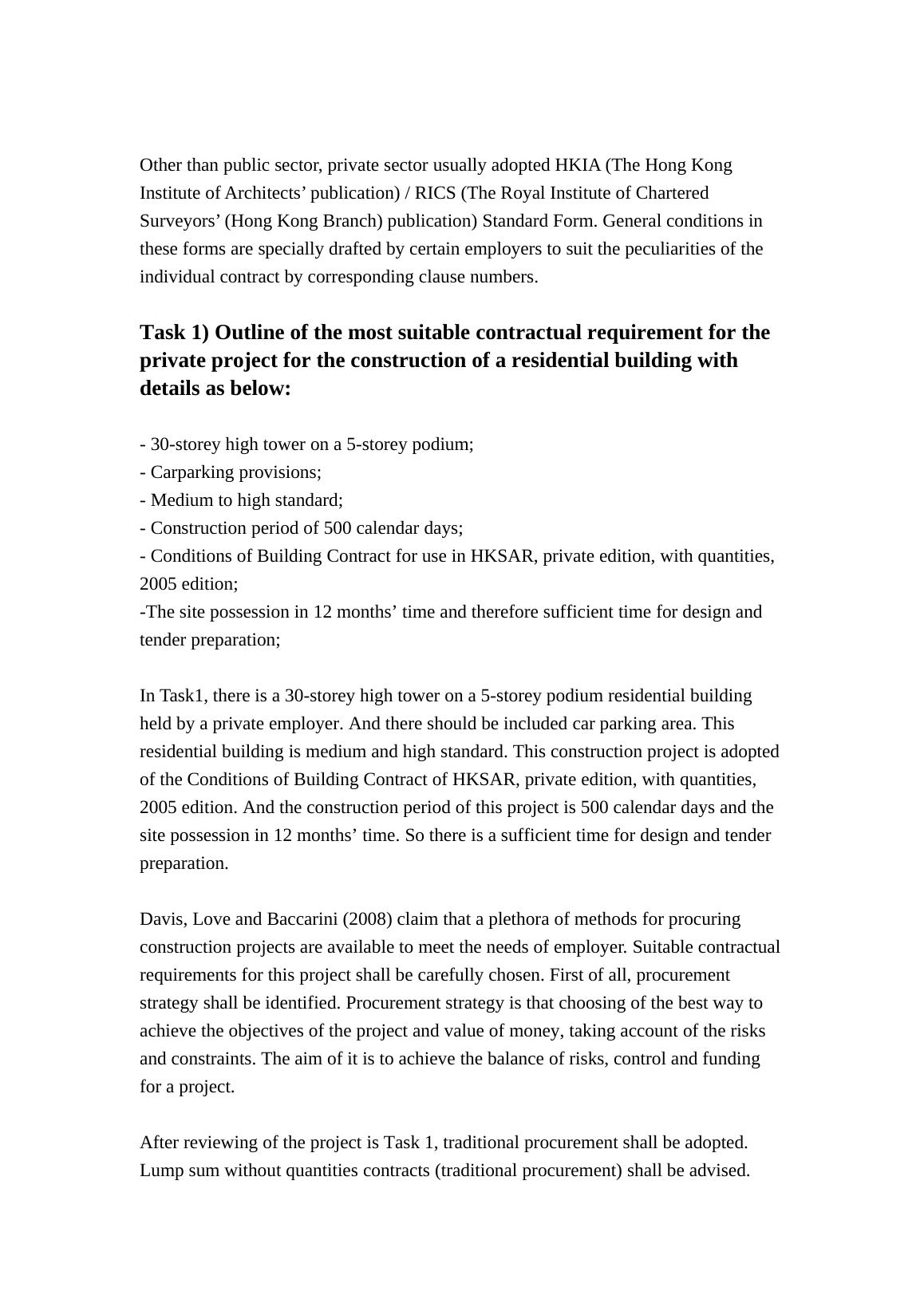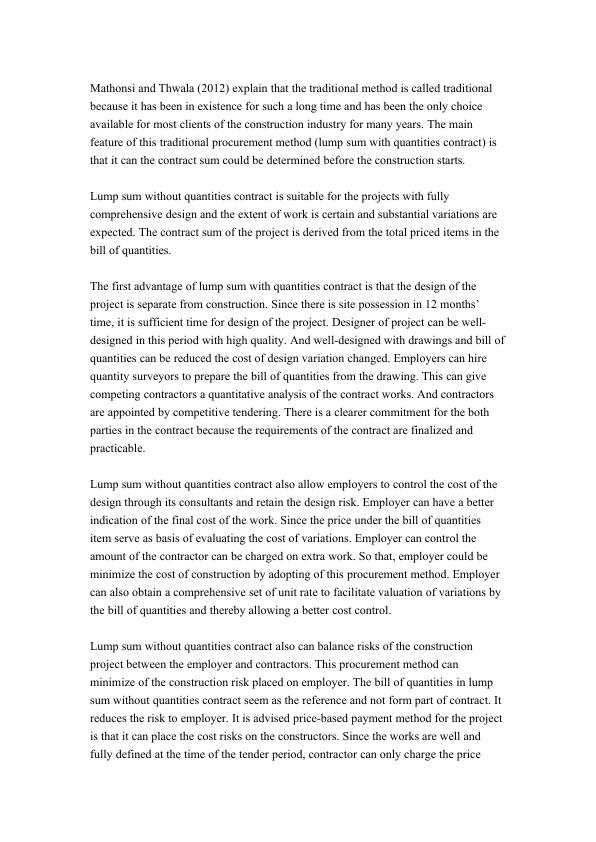legal and contractual requirements for public and private sectors PDF
Added on 2022-01-15
9 Pages3630 Words171 Views
Assignment 1
The legal and contractual requirements for public and private sectors
There are two main construction sectors. They are public sector and private sector in
constructor industry. Public sectors are government organizations. Public sector
comprises of various business enterprises owned and managed by Government. They
are either fully or partly owned by the center or state and come under the separate
ministry. And private sectors are the organizations other than the government
organizations. They are owned and controlled by private individuals or companies are
known as Private Sector.
No matter of the public sector and private sector, both sectors are under the Legal
system of Hong Kong. So that public sectors and private sectors should under the
Hong Kong Legal system. First of all, we shall understand the sources of Hong Kong
Law. The sources of Hong Kong Law are including of National Law, Basic Law,
Common Law and rules of Equity, Statutes enacted in Hong Kong, Chinese
customary Law and International Law.
Forming a construction contract is aimed to have a legally binding agreement made
between parties. Ricahrds (2011) claimed that with Anson’s Law of contract
“A contract is a legally binding agreement made between two or more parties, by
which rights are acquired by one or more to acts or forbearances on the part of the
other or others.”
While contract is formed, it is a promise or a set of promises which the law will
enforce. And it is essential to set out all the details of the works in a proper form of
contract, and the state of each party’s duties, obligations, and rights. Any failures to do
may cause difficulties and lead to arbitration or court proceedings. Therefore, standard
forms of contract are common practice to use in construction industry.
Public Sectors are usually adopted standard forms in contract documents. Standards
Forms including standard clauses for discharge of contract. Settlement of claims via
agreed paths instead of expensive legal litigations. Since the involved parties aware of
their contractual duties, obligations and rights which are written in related clauses of
standards forms, any vagueness or ambiguity can be avoided.
The legal and contractual requirements for public and private sectors
There are two main construction sectors. They are public sector and private sector in
constructor industry. Public sectors are government organizations. Public sector
comprises of various business enterprises owned and managed by Government. They
are either fully or partly owned by the center or state and come under the separate
ministry. And private sectors are the organizations other than the government
organizations. They are owned and controlled by private individuals or companies are
known as Private Sector.
No matter of the public sector and private sector, both sectors are under the Legal
system of Hong Kong. So that public sectors and private sectors should under the
Hong Kong Legal system. First of all, we shall understand the sources of Hong Kong
Law. The sources of Hong Kong Law are including of National Law, Basic Law,
Common Law and rules of Equity, Statutes enacted in Hong Kong, Chinese
customary Law and International Law.
Forming a construction contract is aimed to have a legally binding agreement made
between parties. Ricahrds (2011) claimed that with Anson’s Law of contract
“A contract is a legally binding agreement made between two or more parties, by
which rights are acquired by one or more to acts or forbearances on the part of the
other or others.”
While contract is formed, it is a promise or a set of promises which the law will
enforce. And it is essential to set out all the details of the works in a proper form of
contract, and the state of each party’s duties, obligations, and rights. Any failures to do
may cause difficulties and lead to arbitration or court proceedings. Therefore, standard
forms of contract are common practice to use in construction industry.
Public Sectors are usually adopted standard forms in contract documents. Standards
Forms including standard clauses for discharge of contract. Settlement of claims via
agreed paths instead of expensive legal litigations. Since the involved parties aware of
their contractual duties, obligations and rights which are written in related clauses of
standards forms, any vagueness or ambiguity can be avoided.

Other than public sector, private sector usually adopted HKIA (The Hong Kong
Institute of Architects’ publication) / RICS (The Royal Institute of Chartered
Surveyors’ (Hong Kong Branch) publication) Standard Form. General conditions in
these forms are specially drafted by certain employers to suit the peculiarities of the
individual contract by corresponding clause numbers.
Task 1) Outline of the most suitable contractual requirement for the
private project for the construction of a residential building with
details as below:
- 30-storey high tower on a 5-storey podium;
- Carparking provisions;
- Medium to high standard;
- Construction period of 500 calendar days;
- Conditions of Building Contract for use in HKSAR, private edition, with quantities,
2005 edition;
-The site possession in 12 months’ time and therefore sufficient time for design and
tender preparation;
In Task1, there is a 30-storey high tower on a 5-storey podium residential building
held by a private employer. And there should be included car parking area. This
residential building is medium and high standard. This construction project is adopted
of the Conditions of Building Contract of HKSAR, private edition, with quantities,
2005 edition. And the construction period of this project is 500 calendar days and the
site possession in 12 months’ time. So there is a sufficient time for design and tender
preparation.
Davis, Love and Baccarini (2008) claim that a plethora of methods for procuring
construction projects are available to meet the needs of employer. Suitable contractual
requirements for this project shall be carefully chosen. First of all, procurement
strategy shall be identified. Procurement strategy is that choosing of the best way to
achieve the objectives of the project and value of money, taking account of the risks
and constraints. The aim of it is to achieve the balance of risks, control and funding
for a project.
After reviewing of the project is Task 1, traditional procurement shall be adopted.
Lump sum without quantities contracts (traditional procurement) shall be advised.
Institute of Architects’ publication) / RICS (The Royal Institute of Chartered
Surveyors’ (Hong Kong Branch) publication) Standard Form. General conditions in
these forms are specially drafted by certain employers to suit the peculiarities of the
individual contract by corresponding clause numbers.
Task 1) Outline of the most suitable contractual requirement for the
private project for the construction of a residential building with
details as below:
- 30-storey high tower on a 5-storey podium;
- Carparking provisions;
- Medium to high standard;
- Construction period of 500 calendar days;
- Conditions of Building Contract for use in HKSAR, private edition, with quantities,
2005 edition;
-The site possession in 12 months’ time and therefore sufficient time for design and
tender preparation;
In Task1, there is a 30-storey high tower on a 5-storey podium residential building
held by a private employer. And there should be included car parking area. This
residential building is medium and high standard. This construction project is adopted
of the Conditions of Building Contract of HKSAR, private edition, with quantities,
2005 edition. And the construction period of this project is 500 calendar days and the
site possession in 12 months’ time. So there is a sufficient time for design and tender
preparation.
Davis, Love and Baccarini (2008) claim that a plethora of methods for procuring
construction projects are available to meet the needs of employer. Suitable contractual
requirements for this project shall be carefully chosen. First of all, procurement
strategy shall be identified. Procurement strategy is that choosing of the best way to
achieve the objectives of the project and value of money, taking account of the risks
and constraints. The aim of it is to achieve the balance of risks, control and funding
for a project.
After reviewing of the project is Task 1, traditional procurement shall be adopted.
Lump sum without quantities contracts (traditional procurement) shall be advised.

Mathonsi and Thwala (2012) explain that the traditional method is called traditional
because it has been in existence for such a long time and has been the only choice
available for most clients of the construction industry for many years. The main
feature of this traditional procurement method (lump sum with quantities contract) is
that it can the contract sum could be determined before the construction starts.
Lump sum without quantities contract is suitable for the projects with fully
comprehensive design and the extent of work is certain and substantial variations are
expected. The contract sum of the project is derived from the total priced items in the
bill of quantities.
The first advantage of lump sum with quantities contract is that the design of the
project is separate from construction. Since there is site possession in 12 months’
time, it is sufficient time for design of the project. Designer of project can be well-
designed in this period with high quality. And well-designed with drawings and bill of
quantities can be reduced the cost of design variation changed. Employers can hire
quantity surveyors to prepare the bill of quantities from the drawing. This can give
competing contractors a quantitative analysis of the contract works. And contractors
are appointed by competitive tendering. There is a clearer commitment for the both
parties in the contract because the requirements of the contract are finalized and
practicable.
Lump sum without quantities contract also allow employers to control the cost of the
design through its consultants and retain the design risk. Employer can have a better
indication of the final cost of the work. Since the price under the bill of quantities
item serve as basis of evaluating the cost of variations. Employer can control the
amount of the contractor can be charged on extra work. So that, employer could be
minimize the cost of construction by adopting of this procurement method. Employer
can also obtain a comprehensive set of unit rate to facilitate valuation of variations by
the bill of quantities and thereby allowing a better cost control.
Lump sum without quantities contract also can balance risks of the construction
project between the employer and contractors. This procurement method can
minimize of the construction risk placed on employer. The bill of quantities in lump
sum without quantities contract seem as the reference and not form part of contract. It
reduces the risk to employer. It is advised price-based payment method for the project
is that it can place the cost risks on the constructors. Since the works are well and
fully defined at the time of the tender period, contractor can only charge the price
because it has been in existence for such a long time and has been the only choice
available for most clients of the construction industry for many years. The main
feature of this traditional procurement method (lump sum with quantities contract) is
that it can the contract sum could be determined before the construction starts.
Lump sum without quantities contract is suitable for the projects with fully
comprehensive design and the extent of work is certain and substantial variations are
expected. The contract sum of the project is derived from the total priced items in the
bill of quantities.
The first advantage of lump sum with quantities contract is that the design of the
project is separate from construction. Since there is site possession in 12 months’
time, it is sufficient time for design of the project. Designer of project can be well-
designed in this period with high quality. And well-designed with drawings and bill of
quantities can be reduced the cost of design variation changed. Employers can hire
quantity surveyors to prepare the bill of quantities from the drawing. This can give
competing contractors a quantitative analysis of the contract works. And contractors
are appointed by competitive tendering. There is a clearer commitment for the both
parties in the contract because the requirements of the contract are finalized and
practicable.
Lump sum without quantities contract also allow employers to control the cost of the
design through its consultants and retain the design risk. Employer can have a better
indication of the final cost of the work. Since the price under the bill of quantities
item serve as basis of evaluating the cost of variations. Employer can control the
amount of the contractor can be charged on extra work. So that, employer could be
minimize the cost of construction by adopting of this procurement method. Employer
can also obtain a comprehensive set of unit rate to facilitate valuation of variations by
the bill of quantities and thereby allowing a better cost control.
Lump sum without quantities contract also can balance risks of the construction
project between the employer and contractors. This procurement method can
minimize of the construction risk placed on employer. The bill of quantities in lump
sum without quantities contract seem as the reference and not form part of contract. It
reduces the risk to employer. It is advised price-based payment method for the project
is that it can place the cost risks on the constructors. Since the works are well and
fully defined at the time of the tender period, contractor can only charge the price

End of preview
Want to access all the pages? Upload your documents or become a member.
Related Documents
Contractual arrangements for a 30-storey tower on a 5-storey podiumlg...
|12
|4171
|136
Conditions and Warranties in Australian Contract Lawlg...
|10
|2762
|265
Business Law Assignment (Solved)lg...
|9
|2395
|61
Formation of contractual relationshipslg...
|8
|2152
|75
Law for Business Managerslg...
|11
|3803
|1
Business Law and Ethics: Formation of Contract and Rights and Responsibilitieslg...
|6
|1900
|67
